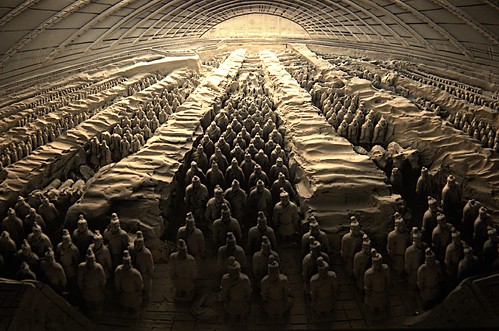Around 260 BCE China was in the midst of the "Warring States Period." The country was split into several different states battling each other to take over China. In 247 BCE a young man named Ying Zheng rose to power in the Qin Dynasty and by 221 BCE untied all of modern day China. After becoming Emperor Zheng renamed himself Qin Shihuangdi, which translates to "First Emperor of the Qin."
Shihuangdi was an extraordinary leader. During his time as Emperor he constructed an extensive network of roads and canals that connected the entire country, abandoned feudalism in favor of a system based on provinces run by civilian governors, and standardized money and written language. He is also credited with connecting existing walls to create the first version of the Great Wall. Shihuangdi imposed many other important reforms, including the standardization of weights and measures and the codification of law. The reforms benefited both the economy and cultural exchange during the period.
Shihuangdi was an extraordinary leader. During his time as Emperor he constructed an extensive network of roads and canals that connected the entire country, abandoned feudalism in favor of a system based on provinces run by civilian governors, and standardized money and written language. He is also credited with connecting existing walls to create the first version of the Great Wall. Shihuangdi imposed many other important reforms, including the standardization of weights and measures and the codification of law. The reforms benefited both the economy and cultural exchange during the period.

Qin Shihuangdi was also a very brutal leader. He imposed harsh laws and severe punishments to reinforce his rule. He executed all scholars and their families who opposed his rule. In 212 BCE Shihuangdi decided to burn all books in the empire and kill nearly five hundred Confucian Scholars by burning them alive to silence criticism and terrorize his people into obeying his rules.

Throughout Shihuangdi's reign he was on a mission to make himself immortal. He believed mercury was a medicine that could make a person immortal so he began drinking in his later years. The mercury poisoned his mind and eventually killed him. Shihuangdi's greatest attempt to make himself immortal was the construction of a semi-subterranean mausoleum complex and an army of 7,000 life-sized clay terracotta soldiers, horses and chariots. The outer wall of the complex measured 2100 x 975 meters and in the center was a 500 x 500 meter tomb for Shihuangdi. The mausoleum contained for pits that held over 7,000 clay soldiers, 130 chariots with horses, 110 cavalry horses, administrative buildings, bronze sculptures and horse stables. Shihuangdi built this complex to protect his soul after his death and to ensure his reign into the afterlife.
Information was taken from the following websites:
http://www.chinaculture.org/gb/en_aboutchina/2003-09/24/content_22854.htm
http://archaeology.about.com/od/china/a/terracotta.htm